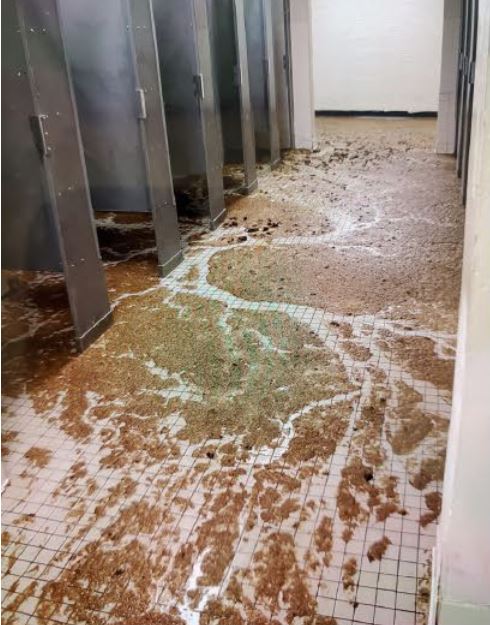‘We lost the bubble’: Defense officials acknowledge chronic underfunding that’s caused health, safety risks in military barracks
Service members at all 10 installations the Government Accountability Office visited said their living conditions were poor enough to take a toll on their mental...
Defense officials acknowledged Wednesday that they haven’t done nearly enough to provide decent housing for junior military service members after a scathing audit found widespread health and safety risks in government-owned barracks on military bases.
In site visits, the Government Accountability Office found problems like overflowing sewage, mold and mildew, broken locks and air conditioning systems, and numerous other ways “unaccompanied housing” falls short of DoD’s own housing facility standards.
And despite recognizing the problem, the military services likely don’t understand its full scope — partly because DoD doesn’t have a complete picture of what it’s spending to maintain barracks, and partly because it stopped asking service members what they think of their own living conditions several years ago, said Elizabeth Field, GAO’s director for defense capabilities and management.
“Military barracks are used to house our most junior enlisted service members, many of them teenagers fresh out of high school. Unfortunately, because of this, we found that many — although not all — department officials have chosen not to obtain their input,” Field told the House Armed Services Committee Wednesday. “According to these officials, this demographic group is so unreliable in terms of completing surveys or replying to email or telephone inquiries that it isn’t worth trying to solicit their opinion. Other officials told us that the condition of barracks is not a key factor in military retention, and therefore doesn’t merit inclusion as a topic in already-lengthy surveys. What we learned, however, is that these service members have a lot to say, and are eager for someone to listen.”
When GAO held a dozen listening sessions at 10 installations, service members at each one said their living conditions were poor enough to take a toll on their mental health. Physical safety frequently came up too: At multiple installations, auditors heard from members who said sexual assault and theft was a problem because of broken locks and security cameras, and GAO found evidence that vagrants were sleeping in unoccupied rooms.
“We heard from residents of barracks that because they are so uncomfortable in their rooms, they have a hard time sleeping. They’re tired on the job. They don’t feel like they can perform and focus on the work that they have to do,” Field said. “We also heard from first sergeants who are responsible for training these junior enlisted service members who told us specifically that sometimes they take it easier on them in training: They will cut back the length of runs or specific drills because they know they’re going home to the barracks at night. So there are clear readiness implications there.”
When asked how the problems became so severe, Defense officials said GAO’s findings didn’t come as a surprise.
“I think it’s through many years of not looking closely at the deferred maintenance, and so now we are in effect playing catch up,” said Carla Coulson, the deputy assistant secretary of the Army for installations, housing and partnerships. “This report, frankly, was not news to the Army. We’re well aware, and our leadership from our secretary and chief of staff on down are focusing very clearly on quality of life — and barracks is a piece of that.”
The Army is by far the biggest operator of government-owned barracks. Out of 9,000 across the military services, the Army owns 6,700 of them. Coulson said 23% have been formally designated as being in “poor” or “failing” condition, and the Army is now spending about $1.2 billion a year in restoration and modernization funds to improve them.
According to GAO though, across the military services, there’s a total deferred maintenance backlog of about $137 billion. Field said that’s likely an underestimate, and DoD doesn’t have reliable data on the true conditions of its barracks, which are supposed to undergo thorough inspections every five years.
“For example, we went to a facility in the DC area that had a score of 86 out of 100, which sounds pretty good. But that facility had a quarter of its air conditioning broken. A quarter of residents had no air conditioning, and yet it still had an 86,” she said. “That happened again and again: We would go to installations and the scores just did not make sense, so we tried to figure out what’s going on.”
Field said GAO identified at least a few issues that might explain the disconnect.
“Installation commanders told us five years is not frequent enough, and in some cases, they weren’t even doing them that frequently,” she said. “Another one is the number of systems that they’re assessing. There are 13 building systems they’re supposed to be assessing, and in some cases, they don’t always do that. Another is the training of the inspectors. There’s no standard right now. The Air Force hires personnel with expertise to do the inspections and the same team will go out and inspect various barracks across the service. Others have a decentralized model. So we have a recommendation to DoD to reassess everything from requirements for frequency to standards to inspector training.”
Robert Thompson, the principal deputy assistant secretary of the Navy for energy, installations and environment, said in the wake of the GAO report, officials from the military services and the Office of the Secretary of Defense have started reexamining those 13 building standards — and whether they’re the right ones to use for living spaces.
“There needs to be a standard for livability. There needs to be a plain, clear-eyed view of what the standard is for a place to be dignified, safe and comfortable,” he said. “I think we’ve taken our general expertise in facilities and just moved it right on over to barracks, and then we expect that to serve us well. Even if we trained everyone, even if we had consistency in application, I think we’d still be missing something there.”
In recent years, the military services have habitually underfunded maintenance for all of their facilities — spending only about 80% of what DoD’s own models say is needed to keep buildings in good shape. But even within that larger underfunded pie, barracks have tended to get the short end of the stick. Field said the same is true for military construction funding.
“A lot of times, even though installations know they need funding for constructing new barracks, they don’t feel comfortable requesting that funding because they know it won’t compete well against other requirements, so they don’t request it. It really is a matter of chronic underfunding at the DoD level,” she said. “And eventually if you don’t fund sustainment enough, you’re going to need to build an entirely new barracks, which means you need even more military construction funding … I think there’s also a lack of accountability. I think there has been a cultural perspective within the department that part of being in the military is toughing it out, and that this is just going to get [junior service members] ready for the military. Unfortunately, I think that has that has gotten us, in part, to where we are today.”
Robert Moriarty, the deputy assistant secretary of the Air Force for installations, said his service recognizes the underfunding problem, and has been making moves to give barracks their own dedicated funding source.
“I think the Air Force did lose the bubble. We used to have a dorm focus fund, but we went away from that when we centralized a lot of our installation management and put all the money together,” he said. “We’ve now gone back to having that focus fund where we set aside the amount of funds we think we need to keep the dorms good and accelerate that. They do compete in the topline budget, but they compete among themselves so we can target our investments at our worst dorms first.”
In all, GAO made 31 recommendations in its latest report. DoD concurred with most of them.
But Field said Congress may want to turn those recommendations into law, because it’s not the first time DoD has agreed to implement fixes even as the problem continues to worsen. She said GAO brought some of the same issues to the department’s attention during audits 10 years ago and 20 years ago.
“If we don’t see the department implement all 31 of our recommendations in a meaningful and timely manner, I would encourage you to consider making them statutorily required,” she told lawmakers. “That is something that has happened with privatized family housing, and I think that has been effective. The department concurred with most of our recommendations, but in some cases, they were partial concurrences, and statements that they’ve already implemented the recommendations, and so they’re good. They’re not good.”
Copyright © 2025 Federal News Network. All rights reserved. This website is not intended for users located within the European Economic Area.
Jared Serbu is deputy editor of Federal News Network and reports on the Defense Department’s contracting, legislative, workforce and IT issues.
Follow @jserbuWFED









